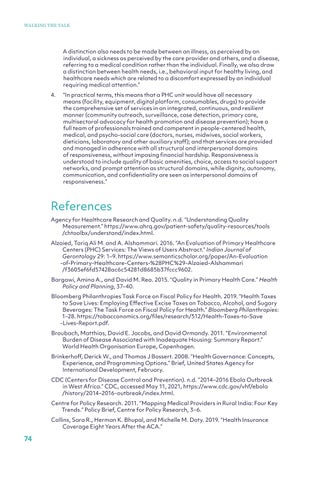WALKING THE TALK
A distinction also needs to be made between an illness, as perceived by an individual, a sickness as perceived by the care provider and others, and a disease, referring to a medical condition rather than the individual. Finally, we also draw a distinction between health needs, i.e., behavioral input for healthy living, and healthcare needs which are related to a discomfort expressed by an individual requiring medical attention.” 4.
“In practical terms, this means that a PHC unit would have all necessary means (facility, equipment, digital platform, consumables, drugs) to provide the comprehensive set of services in an integrated, continuous, and resilient manner (community outreach, surveillance, case detection, primary care, multisectoral advocacy for health promotion and disease prevention); have a full team of professionals trained and competent in people-centered health, medical, and psycho-social care (doctors, nurses, midwives, social workers, dieticians, laboratory and other auxiliary staff); and that services are provided and managed in adherence with all structural and interpersonal domains of responsiveness, without imposing financial hardship. Responsiveness is understood to include quality of basic amenities, choice, access to social support networks, and prompt attention as structural domains, while dignity, autonomy, communication, and confidentiality are seen as interpersonal domains of responsiveness.”
References Agency for Healthcare Research and Quality. n.d. “Understanding Quality Measurement.” https://www.ahrq.gov/patient-safety/quality-resources/tools /chtoolbx/understand/index.html. Alzaied, Tariq Ali M. and A. Alshammari. 2016. “An Evaluation of Primary Healthcare Centers (PHC) Services: The Views of Users Abstract.” Indian Journal of Gerontology 29: 1–9. https://www.semanticscholar.org/paper/An-Evaluation -of-Primary-Healthcare-Centers-%28PHC%29-Alzaied-Alshammari /f3605ef6fd57428ac6c54281d8685b37fccc9602. Bargawi, Amina A., and David M. Rea. 2015. “Quality in Primary Health Care.” Health Policy and Planning, 37–40. Bloomberg Philanthropies Task Force on Fiscal Policy for Health. 2019. “Health Taxes to Save Lives: Employing Effective Excise Taxes on Tobacco, Alcohol, and Sugary Beverages: The Task Force on Fiscal Policy for Health.” Bloomberg Philanthropies: 1–28. https://tobacconomics.org/files/research/512/Health-Taxes-to-Save -Lives-Report.pdf. Braubach, Matthias, David E. Jacobs, and David Ormandy. 2011. “Environmental Burden of Disease Associated with Inadequate Housing: Summary Report.” World Health Organisation Europe, Copenhagen. Brinkerhoff, Derick W., and Thomas J Bossert. 2008. “Health Governance: Concepts, Experience, and Programming Options.” Brief, United States Agency for International Development, February. CDC (Centers for Disease Control and Prevention). n.d. “2014–2016 Ebola Outbreak in West Africa.” CDC, accessed May 11, 2021, https://www.cdc.gov/vhf/ebola /history/2014–2016-outbreak/index.html. Centre for Policy Research. 2011. “Mapping Medical Providers in Rural India: Four Key Trends.” Policy Brief, Centre for Policy Research, 3–6. Collins, Sara R., Herman K. Bhupal, and Michelle M. Doty. 2019. “Health Insurance Coverage Eight Years After the ACA.”
74


